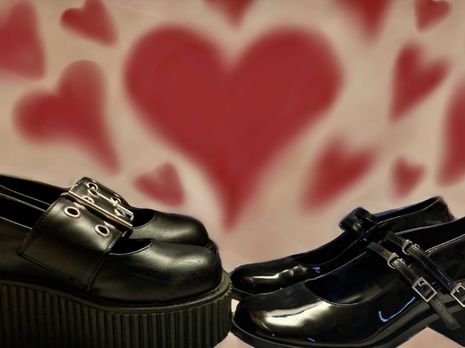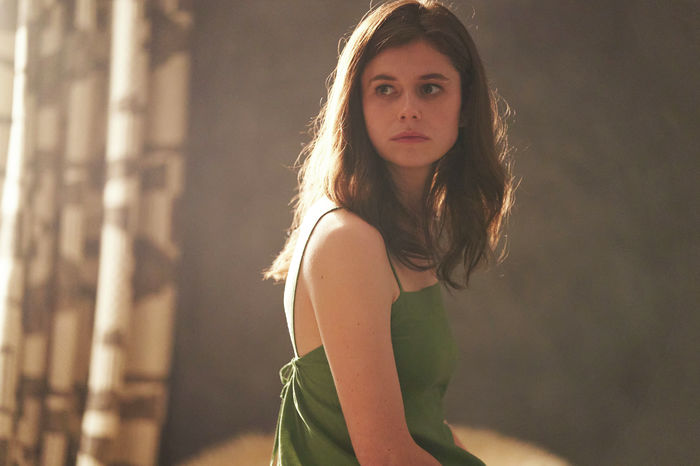Why Do We Love You, Mary Jane?
Yen Min Ting unpicks her desire for a pair of Mary Jane shoes and how consumerism relates to personal identity

With their incredibly chunky soles and large leather strap, oversized buckle and rounded leather toe, the chunky Mary Jane heels and their iconic silhouette are unmistakable everywhere. And I need them.
Originally known as bar shoes, the shoe was only given its name after the appearance of the character Mary Jane in a 1902 comic strip titled Buster Brown, written by R. F. Outcault. However, the original Mary Jane shoes only made their first appearance on the runway in the 1960’s. With their runway debut, they brought with them a fresh, new, ‘schoolgirl style’ into the high-fashion world. The 1960’s version was a distant, more classical relative of the thick-soled platforms that we have now: they originally premiered with a much lower heel, and a thinner strap. The explosion of punk in the 1990s, however, made these shoes metamorphosise into something a little closer to what we have today. The Mary Janes were no longer the trademark of the average, clean-cut woman: instead, punk rockers and alternative it-girls like Courtney Love sported these jet-black heels. Their innocent look only added to the jarring juxtaposition of punk subculture.
The chokehold of the Mary Jane heel-turned-platform still hasn’t really loosened. It’s undeniable that there have been glimpses of it everywhere—since their resurfacing in the mid-2000s, these platforms have been the staple of the outfits of many.
“Punk or elegant; dress them up or down, and the Mary Jane heels will willingly comply”
But who can blame them? Their grunge look bears similarities to other staple shoes like Doc Martens, but instead, their surprising childlikeness paired with punk-style thick soles is what makes them so very distinctive. These add a new layer of dimension to an otherwise delicate, feminine style. Automatically, your sense of style is cooler, more varied, additionally complex. Mary Jane’s ever-expanding repertoire includes the shoes in every colour imaginable, all to cater to one’s sense of individuality. Even in their classic black, the versatility of these shoes is impossible to avoid. It’s too easy of a fix, and it checks all the boxes: punk or elegant; dress them up or down, and the Mary Jane heels will willingly comply. Frankly, it’s difficult not to see the easy allure of these distinctive heels.
My own love affair with the Mary Jane began when I saw her with other girls. There’s the iconic model-turned-fashion designer, Alexa Chung, who famously pairs these shoes with a pair of kick flare jeans and a plain sweater, often with bold-coloured graphics or stripes. Its genius lies in its simplicity, and the Mary Jane heels absolutely shine as the staple of the outfit. Then there were other fashion icons, such as model Bella Hadid and YouTuber Mina Le, with an albeit more classical, low-heeled look. Just last year, L’Officiel even named Mary Janes as the “timeless” and “go-to shoe for fashion girls.” Now, the shoes weren’t merely a nice fashion item to have—instead, they translated into an unachievable identity that I was constantly aspiring towards. These shoes would grant me access to an exclusive club of ‘it girls’, signifying a status on par with the fashionistas I so desperately want to emulate.
However, upon a closer look, Mary Janes are simply just what they are—shoes. If intrinsic identity was so easily transformable by an article of clothing, we would never be able to hold onto any kind of identity for long. I began to think about other articles of clothes in my wardrobe: had they contributed meaningfully to my outward identity? Or were they merely remnants of a past trend that I hung onto desperately, wanting so badly to appear ‘fashionable’? (Several pastel-patterned kerchief bandanas balled up at the back of my wardrobe, so far untouched since the ‘cottagecore’ rage, still haunt me till today.)
The exploration of my desire for these shoes allowed me to dissect how conformity affected my wardrobe, now a collection of mismatched garments that no longer represent my own style. Though we can certainly aspire to own a fashion product, I’ve learnt over the years (and after several dusty, unused purchases) that we should also be critical of our aspiration. In an age with scarily accurate advertising tactics, it’s getting easier to fall into the trend of an unsatisfying, never-ending consumption of products in hopes it’ll finally make us the grunge ‘it girl’ we all look up to. What seems to be aspiration may simply be rampant consumerism veiled and dressed up by excellent marketing tactics and social media pressure.
Youtuber Katie Yoo has an excellent tip about differentiating desire from pressure: she recommends sitting on a product for up to three months before deciding on a purchase, long after the trend has passed. Currently, I’ve been sitting on the Mary Jane platforms for about two months now. Maybe after the third-month mark, I might just find that I won’t need them anymore.
 Interviews / You don’t need to peak at Cambridge, says Robin Harding31 December 2025
Interviews / You don’t need to peak at Cambridge, says Robin Harding31 December 2025 News / Downing investigates ‘mysterious’ underground burial vault 29 December 2025
News / Downing investigates ‘mysterious’ underground burial vault 29 December 2025 News / Unions protest handling of redundancies at Epidemiology Unit30 December 2025
News / Unions protest handling of redundancies at Epidemiology Unit30 December 2025 Lifestyle / Ask Auntie Alice29 December 2025
Lifestyle / Ask Auntie Alice29 December 2025 Features / ‘Treated like we’re incompetent’: ents officers on college micromanagement30 December 2025
Features / ‘Treated like we’re incompetent’: ents officers on college micromanagement30 December 2025









